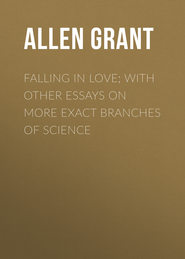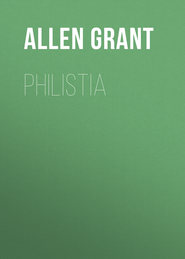По всем вопросам обращайтесь на: info@litportal.ru
(©) 2003-2024.
✖
The Evolutionist at Large
Настройки чтения
Размер шрифта
Высота строк
Поля
The Evolutionist at Large
Grant Allen
The Evolutionist at Large
Dear Mother, take this English posy, culled.
In alien fields beyond the severing sea:
Take it in memory of the boy you lulled
One chill Canadian winter on your knee.
Its flowers are but chance friends of after years,
Whose very names my childhood hardly knew;
And even today far sweeter in my ears
Ring older names unheard long seasons through.
I loved them all – the bloodroot, waxen white,
Canopied mayflower, trilliums red and pale,
Flaunting lobelia, lilies richly dight,
And pipe-plant from the wood behind the Swale.
I knew each dell where yellow violets blow,
Each bud or leaf the changing seasons bring;
I marked each spot where from the melting snow
Peeped forth the first hepatica of spring.
I watched the fireflies on the shingly ridge
Beside the swamp that bounds the Baron's hill;
Or tempted sunfish by the ebbing bridge,
Or hooked a bass by Shirley Going's mill.
These were my budding fancy's mother-tongue:
But daisies, cowslips, dodder, primrose-hips,
All beasts or birds my little book has sung,
Sit like a borrowed speech on stammering lips.
And still I build fond dreams of happier days,
If hard-earned pence may bridge the ocean o'er;
That yet our boy may see my mother's face,
And gather shells beside Ontario's shore:
May yet behold Canadian woodlands dim,
And flowers and birds his father loved to see;
While you and I sit by and smile on him,
As down grey years you sat and smiled on me.
G. A.
PREFACE
These Essays originally appeared in the columns of the 'St. James's Gazette,' and I have to thank the courtesy of the Editor for kind permission to republish them. My object in writing them was to make the general principles and methods of evolutionists a little more familiar to unscientific readers. Biologists usually deal with those underlying points of structure which are most really important, and on which all technical discussion must necessarily be based. But ordinary people care little for such minute anatomical and physiological details. They cannot be expected to interest themselves in the flexor pollicis longus, or the hippocampus major about whose very existence they are ignorant, and whose names suggest to them nothing but unpleasant ideas. What they want to find out is how the outward and visible forms of plants and animals were produced. They would much rather learn why birds have feathers than why they have a keeled sternum; and they think the origin of bright flowers far more attractive than the origin of monocotyledonous seeds or exogenous stems. It is with these surface questions of obvious outward appearance that I have attempted to deal in this little series. My plan is to take a simple and well-known natural object, and give such an explanation as evolutionary principles afford of its most striking external features. A strawberry, a snail-shell, a tadpole, a bird, a wayside flower – these are the sort of things which I have tried to explain. If I have not gone very deep, I hope at least that I have suggested in simple language the right way to go to work.
I must make an apology for the form in which the essays are cast, so far as regards the apparent egotism of the first person. When they appeared anonymously in the columns of a daily paper, this air of personality was not so obtrusive: now that they reappear under my own name, I fear it may prove somewhat too marked. Nevertheless, to cut out the personal pronoun would be to destroy the whole machinery of the work: so I have reluctantly decided to retain it, only begging the reader to bear in mind that the I of the essays is not a real personage, but the singular number of the editorial we.
I have made a few alterations and corrections in some of the papers, so as to bring the statements into closer accordance with scientific accuracy. At the same time, I should like to add that I have intentionally simplified the scientific facts as far as possible. Thus, instead of saying that the groundsel is a composite, I have said that it is a daisy by family; and instead of saying that the ascidian larva belongs to the sub-kingdom Chordata, I have said that it is a first cousin of the tadpole. For these simplifications, I hope technical biologists will pardon me. After all, if you wish to be understood, it is best to speak to people in words whose meanings they know. Definite and accurate terminology is necessary to express definite and accurate knowledge; but one may use vague expressions where the definite ones would convey no ideas.
I have to thank the kindness of my friend the Rev. E. Purcell, of Lincoln College, Oxford, for the clever and appropriate design which appears upon the cover.
G. A.
A BALLADE OF EVOLUTION
In the mud of the Cambrian main
Did our earliest ancestor dive:
From a shapeless albuminous grain
We mortals our being derive.
He could split himself up into five,
Or roll himself round like a ball;
For the fittest will always survive,
While the weakliest go to the wall.
As an active ascidian again
Fresh forms he began to contrive,
Till he grew to a fish with a brain,
And brought forth a mammal alive.
With his rivals he next had to strive,
To woo him a mate and a thrall;
So the handsomest managed to wive,
While the ugliest went to the wall.
At length as an ape he was fain
The nuts of the forest to rive;
Till he took to the low-lying plain,
And proceeded his fellow to knive.
Thus did cannibal men first arrive,
One another to swallow and maul;
And the strongest continued to thrive,
While the weakliest went to the wall.
Envoy
Prince, in our civilised hive,
Now money's the measure of all;
And the wealthy in coaches can drive,
While the needier go to the wall.
I.
MICROSCOPIC BRAINS
Sitting on this little rounded boss of gneiss beside the path which cuts obliquely through the meadow, I am engaged in watching a brigade of ants out on foraging duty, and intent on securing for the nest three whole segments of a deceased earthworm. They look for all the world like those busy companies one sees in the Egyptian wall-paintings, dragging home a huge granite colossus by sheer force of bone and sinew. Every muscle in their tiny bodies is strained to the utmost as they prise themselves laboriously against the great boulders which strew the path, and which are known to our Brobdingnagian intelligence as grains of sand. Besides the workers themselves, a whole battalion of stragglers runs to and fro upon the broad line which leads to the head-quarters of the community. The province of these stragglers, who seem so busy doing nothing, probably consists in keeping communications open, and encouraging the sturdy pullers by occasional relays of fresh workmen. I often wish that I could for a while get inside those tiny brains, and see, or rather smell, the world as ants do. For there can be little doubt that to these brave little carnivores here the universe is chiefly known as a collective bundle of odours, simultaneous or consecutive. As our world is mainly a world of visible objects, theirs, I believe, is mainly a world of olfactible things.
Grant Allen
The Evolutionist at Large
Dear Mother, take this English posy, culled.
In alien fields beyond the severing sea:
Take it in memory of the boy you lulled
One chill Canadian winter on your knee.
Its flowers are but chance friends of after years,
Whose very names my childhood hardly knew;
And even today far sweeter in my ears
Ring older names unheard long seasons through.
I loved them all – the bloodroot, waxen white,
Canopied mayflower, trilliums red and pale,
Flaunting lobelia, lilies richly dight,
And pipe-plant from the wood behind the Swale.
I knew each dell where yellow violets blow,
Each bud or leaf the changing seasons bring;
I marked each spot where from the melting snow
Peeped forth the first hepatica of spring.
I watched the fireflies on the shingly ridge
Beside the swamp that bounds the Baron's hill;
Or tempted sunfish by the ebbing bridge,
Or hooked a bass by Shirley Going's mill.
These were my budding fancy's mother-tongue:
But daisies, cowslips, dodder, primrose-hips,
All beasts or birds my little book has sung,
Sit like a borrowed speech on stammering lips.
And still I build fond dreams of happier days,
If hard-earned pence may bridge the ocean o'er;
That yet our boy may see my mother's face,
And gather shells beside Ontario's shore:
May yet behold Canadian woodlands dim,
And flowers and birds his father loved to see;
While you and I sit by and smile on him,
As down grey years you sat and smiled on me.
G. A.
PREFACE
These Essays originally appeared in the columns of the 'St. James's Gazette,' and I have to thank the courtesy of the Editor for kind permission to republish them. My object in writing them was to make the general principles and methods of evolutionists a little more familiar to unscientific readers. Biologists usually deal with those underlying points of structure which are most really important, and on which all technical discussion must necessarily be based. But ordinary people care little for such minute anatomical and physiological details. They cannot be expected to interest themselves in the flexor pollicis longus, or the hippocampus major about whose very existence they are ignorant, and whose names suggest to them nothing but unpleasant ideas. What they want to find out is how the outward and visible forms of plants and animals were produced. They would much rather learn why birds have feathers than why they have a keeled sternum; and they think the origin of bright flowers far more attractive than the origin of monocotyledonous seeds or exogenous stems. It is with these surface questions of obvious outward appearance that I have attempted to deal in this little series. My plan is to take a simple and well-known natural object, and give such an explanation as evolutionary principles afford of its most striking external features. A strawberry, a snail-shell, a tadpole, a bird, a wayside flower – these are the sort of things which I have tried to explain. If I have not gone very deep, I hope at least that I have suggested in simple language the right way to go to work.
I must make an apology for the form in which the essays are cast, so far as regards the apparent egotism of the first person. When they appeared anonymously in the columns of a daily paper, this air of personality was not so obtrusive: now that they reappear under my own name, I fear it may prove somewhat too marked. Nevertheless, to cut out the personal pronoun would be to destroy the whole machinery of the work: so I have reluctantly decided to retain it, only begging the reader to bear in mind that the I of the essays is not a real personage, but the singular number of the editorial we.
I have made a few alterations and corrections in some of the papers, so as to bring the statements into closer accordance with scientific accuracy. At the same time, I should like to add that I have intentionally simplified the scientific facts as far as possible. Thus, instead of saying that the groundsel is a composite, I have said that it is a daisy by family; and instead of saying that the ascidian larva belongs to the sub-kingdom Chordata, I have said that it is a first cousin of the tadpole. For these simplifications, I hope technical biologists will pardon me. After all, if you wish to be understood, it is best to speak to people in words whose meanings they know. Definite and accurate terminology is necessary to express definite and accurate knowledge; but one may use vague expressions where the definite ones would convey no ideas.
I have to thank the kindness of my friend the Rev. E. Purcell, of Lincoln College, Oxford, for the clever and appropriate design which appears upon the cover.
G. A.
A BALLADE OF EVOLUTION
In the mud of the Cambrian main
Did our earliest ancestor dive:
From a shapeless albuminous grain
We mortals our being derive.
He could split himself up into five,
Or roll himself round like a ball;
For the fittest will always survive,
While the weakliest go to the wall.
As an active ascidian again
Fresh forms he began to contrive,
Till he grew to a fish with a brain,
And brought forth a mammal alive.
With his rivals he next had to strive,
To woo him a mate and a thrall;
So the handsomest managed to wive,
While the ugliest went to the wall.
At length as an ape he was fain
The nuts of the forest to rive;
Till he took to the low-lying plain,
And proceeded his fellow to knive.
Thus did cannibal men first arrive,
One another to swallow and maul;
And the strongest continued to thrive,
While the weakliest went to the wall.
Envoy
Prince, in our civilised hive,
Now money's the measure of all;
And the wealthy in coaches can drive,
While the needier go to the wall.
I.
MICROSCOPIC BRAINS
Sitting on this little rounded boss of gneiss beside the path which cuts obliquely through the meadow, I am engaged in watching a brigade of ants out on foraging duty, and intent on securing for the nest three whole segments of a deceased earthworm. They look for all the world like those busy companies one sees in the Egyptian wall-paintings, dragging home a huge granite colossus by sheer force of bone and sinew. Every muscle in their tiny bodies is strained to the utmost as they prise themselves laboriously against the great boulders which strew the path, and which are known to our Brobdingnagian intelligence as grains of sand. Besides the workers themselves, a whole battalion of stragglers runs to and fro upon the broad line which leads to the head-quarters of the community. The province of these stragglers, who seem so busy doing nothing, probably consists in keeping communications open, and encouraging the sturdy pullers by occasional relays of fresh workmen. I often wish that I could for a while get inside those tiny brains, and see, or rather smell, the world as ants do. For there can be little doubt that to these brave little carnivores here the universe is chiefly known as a collective bundle of odours, simultaneous or consecutive. As our world is mainly a world of visible objects, theirs, I believe, is mainly a world of olfactible things.











